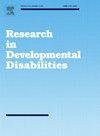赋予生命力量:去机构化和社区生活如何改善智力和发育障碍患者的生活质量。
IF 2.9
2区 医学
Q1 EDUCATION, SPECIAL
引用次数: 0
摘要
背景:近年来,西班牙居住在住宅环境中的智力和发育障碍(IDD)患者的数量没有实质性变化。为了改变这种情况,“我的房子:社区生活”项目旨在促进缺碘症患者和高支持需求的个人向社区环境的过渡。目的:本文加深了对在去机构化过程中观察到的变化的潜在机制的理解。方法:一项纵向研究旨在评估不同环境下IDD患者(n = 90)在两个不同时间点的生活质量:当他们生活在机构中时和过渡到社区环境后的9个月。对照组(n = 72)由仍然住院的个体组成,进行组间比较。使用t检验来估计组间和组内的平均差异。纵向路径模型用于研究变量之间关系的过程。结果:过渡后,运动者在所有具有大或非常大效应量的变量上获得了显著更高的平均得分。然而,仅仅搬到不同的地方并不是造成观察到的改善的因素:生活质量的积极变化需要不断有机会来支持决策。启示:只有当去机构化有利于人们控制自己的生活时,它才会导致生活质量的改善。因此,社区生活不应被理解为一种自主的生活,而应被理解为一种选择的生活。本文章由计算机程序翻译,如有差异,请以英文原文为准。
Empowering lives: How deinstitutionalization and community living improve the quality of life of individuals with intellectual and developmental disabilities
Background
The number of people with intellectual and developmental disabilities (IDD) living in residential settings has not changed substantially in recent years in Spain. To change this situation the project “My House: A Life in the Community” aims to promote the transition of individuals with IDD and high support needs into community settings.
Aims
This paper deepens the understanding of the underlying mechanisms responsible for the changes observed in the process of deinstitutionalization.
Methods
A longitudinal study was designed to evaluate the quality of life of individuals with IDD (n = 90) across different environments at two distinct time points: when they were living in an institution and nine months after transitioning to a community-based setting. A comparison group (n = 72) consisting of individuals who remained institutionalized was included to carry out intergroup comparisons. T-tests were used to estimate mean differences both between and within groups. Longitudinal path models were used to investigate the processes underlying the relationships between variables.
Results
After transition, movers obtained significantly higher mean scores on all variables with large or very large effect sizes. However, simply moving to a different place was not the factor responsible for the observed improvements: positive changes in quality of life require the constant availability of opportunities to support decision making.
Implications
deinstitutionalization will only lead to improvements in quality of life if it favors people’s control over their lives. Community living should therefore be understood not as an autonomous life but as a chosen one.
求助全文
通过发布文献求助,成功后即可免费获取论文全文。
去求助
来源期刊

Research in Developmental Disabilities
Multiple-
CiteScore
5.50
自引率
6.50%
发文量
178
期刊介绍:
Research In Developmental Disabilities is aimed at publishing original research of an interdisciplinary nature that has a direct bearing on the remediation of problems associated with developmental disabilities. Manuscripts will be solicited throughout the world. Articles will be primarily empirical studies, although an occasional position paper or review will be accepted. The aim of the journal will be to publish articles on all aspects of research with the developmentally disabled, with any methodologically sound approach being acceptable.
 求助内容:
求助内容: 应助结果提醒方式:
应助结果提醒方式:


